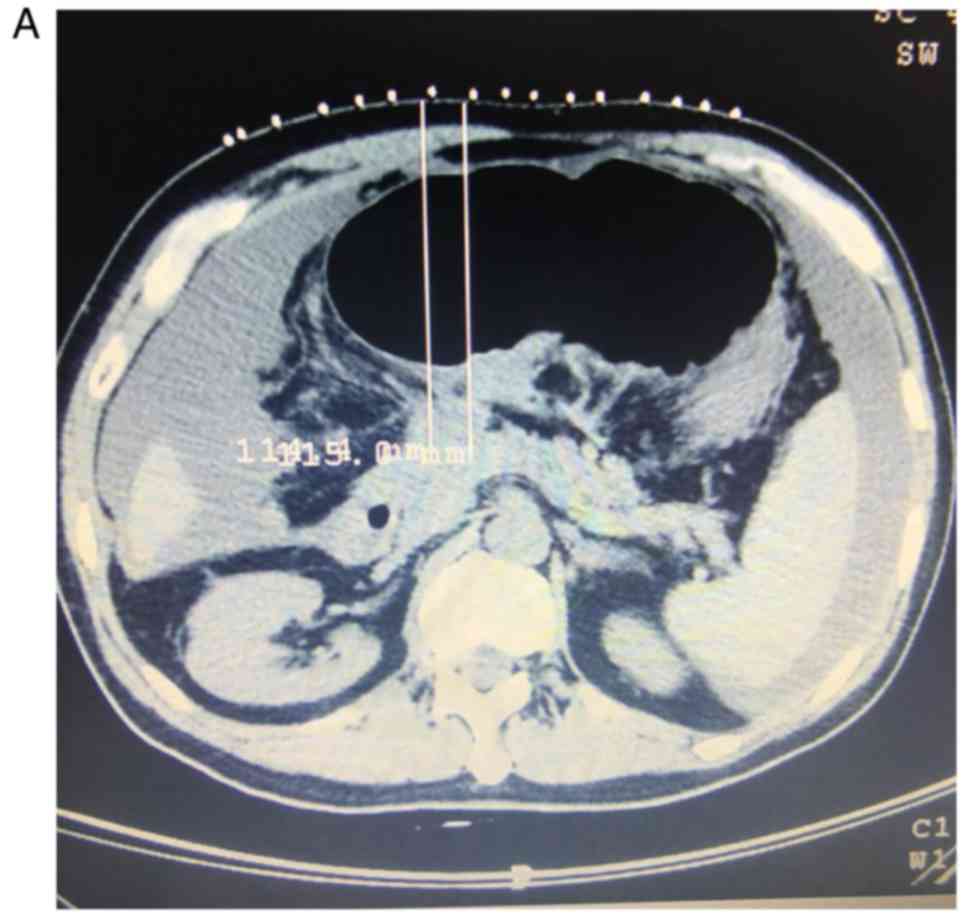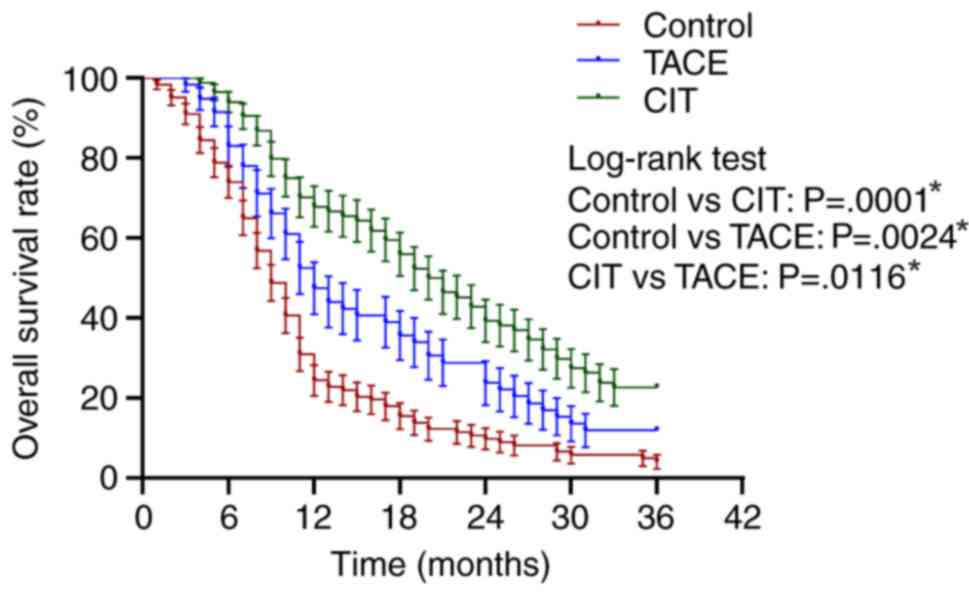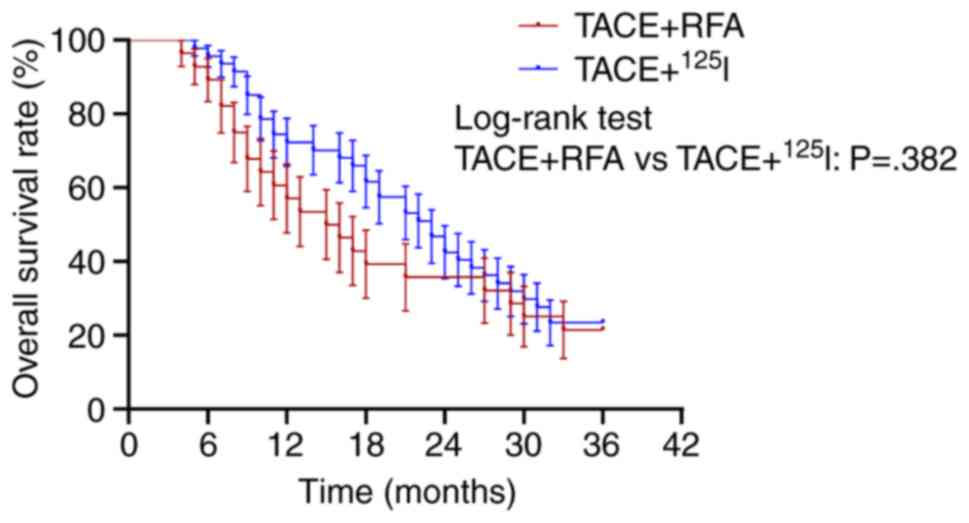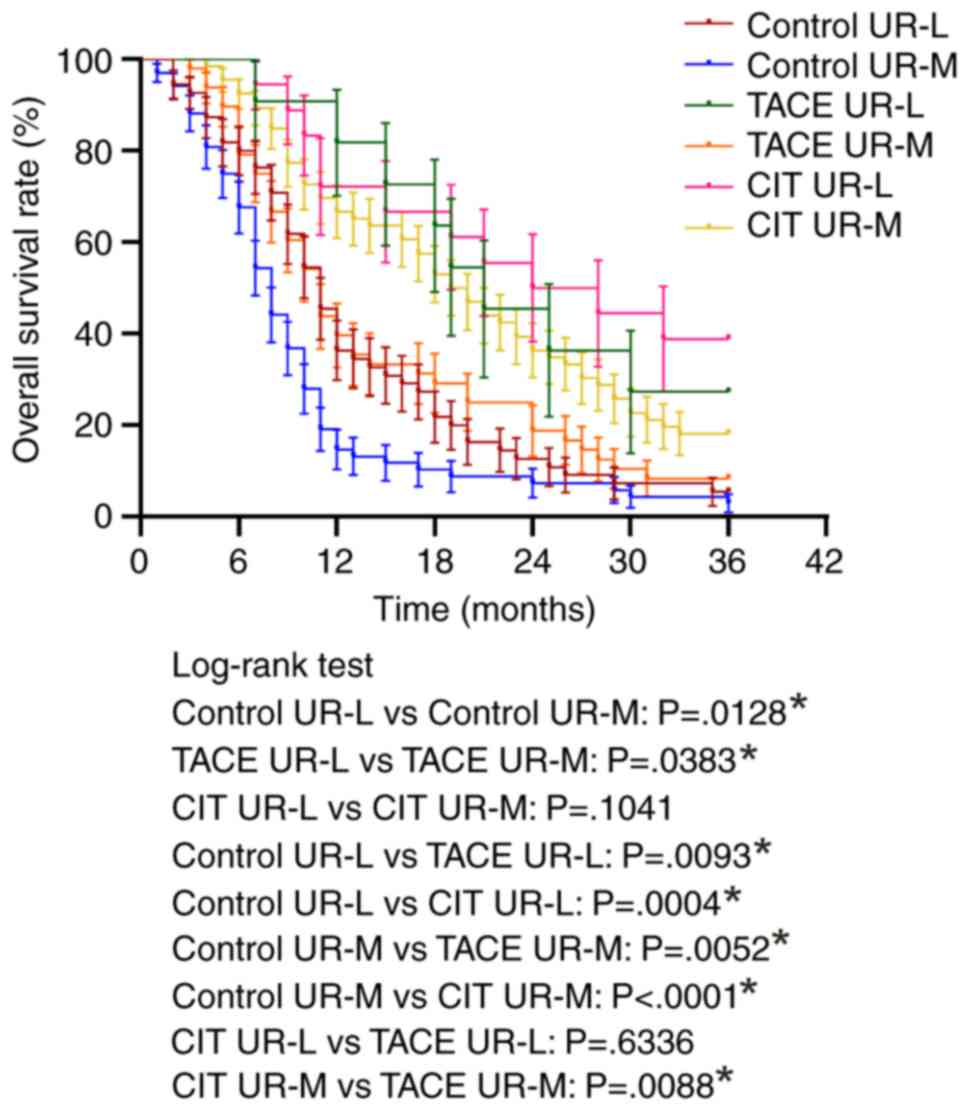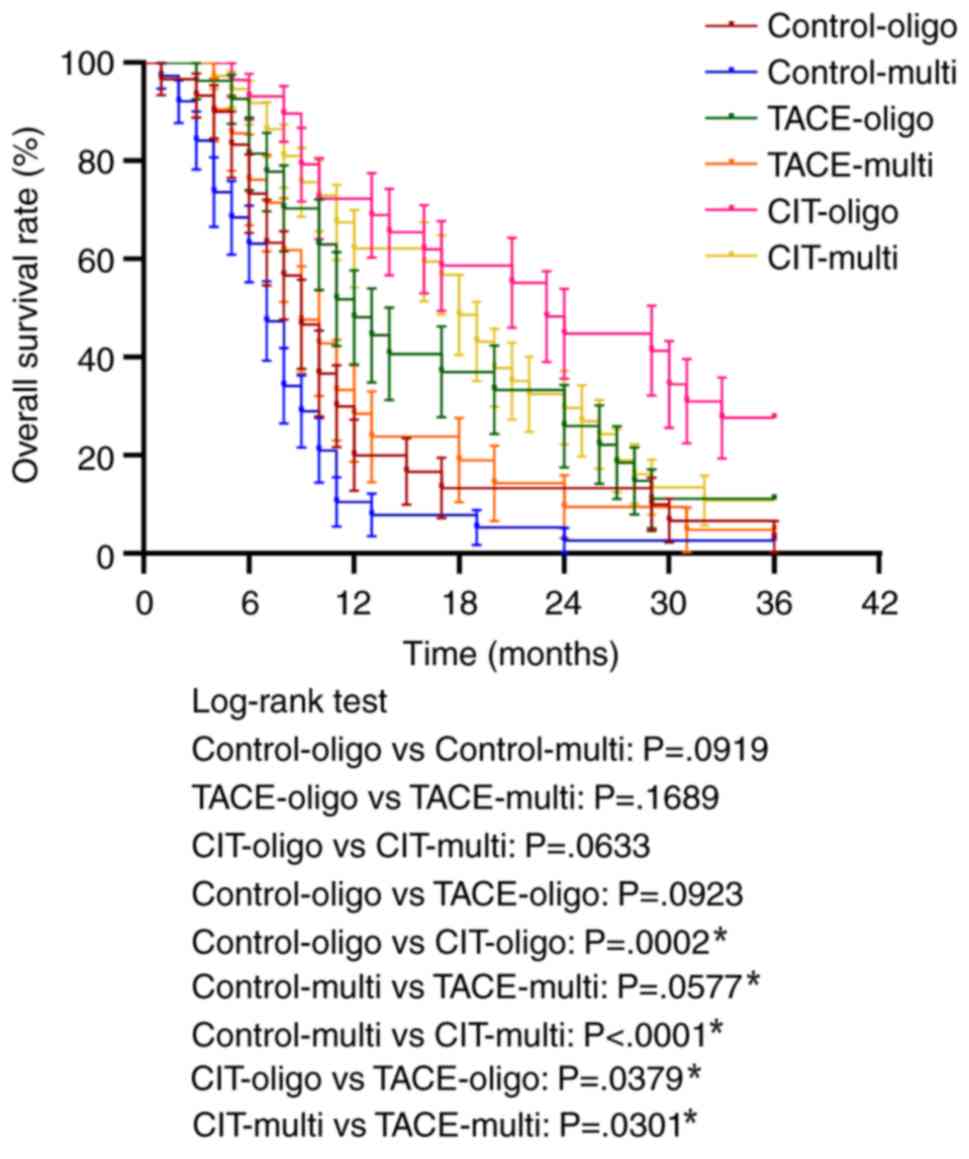|
1
|
Siegel R, Ma J, Zou Z and Jemal A: Cancer
statistics, 2014. CA Cancer J Clin. 64:9–29. 2014. View Article : Google Scholar : PubMed/NCBI
|
|
2
|
Zhang L, Jin H, Guo X, Yang Z, Zhao L,
Tang S, Mo P, Wu K, Nie Y Pan Y and Fan D: Distinguishing
pancreatic cancer from chronic pancreatitis and healthy individuals
by (1) H nuclear magnetic resonance-based metabonomic profiles.
Clin Biochem. 45:1064–1069. 2012. View Article : Google Scholar : PubMed/NCBI
|
|
3
|
Li D, Xie K, Wolff R and Abbruzzese JL:
Pancreatic cancer. Lancet. 363:1049–1057. 2004. View Article : Google Scholar : PubMed/NCBI
|
|
4
|
Siegel R, Naishadham D and Jemal A: Cancer
statistics, 2012. CA Cancer J Clin. 62:10–29. 2012. View Article : Google Scholar : PubMed/NCBI
|
|
5
|
Mao C, Domenico DR, Kim K, Hanson DJ and
Howar JM: Observations on the developmental patterns and the
consequences of pancreatic exocrine adenocarcinoma: Findings of 154
autopsies. Arch Surg. 130:125–134. 1995. View Article : Google Scholar : PubMed/NCBI
|
|
6
|
Kamisawa T, Isawa T, Koike M, Tsuruta K
and Okamoto A: Hematogenous metastases of pancreatic ductal
carcinoma. Pancreas. 11:345–349. 1995. View Article : Google Scholar : PubMed/NCBI
|
|
7
|
Iacobuzio-Donahue CA, Fu B, Yachida S, Luo
M, Abe H, Henderson CM, Vilardell F, Wang Z, Keller JW, Banerjee P,
et al: DPC4 gene status of the primary carcinoma correlates with
patterns of failure in patients with pancreatic cancer. J Clin
Oncol. 27:1806–1813. 2009. View Article : Google Scholar : PubMed/NCBI
|
|
8
|
Frigerio I, Girelli R, Giardino A, Regi P,
Salvia R and Bassi C: Short term chemotherapy followed by
radiofrequency ablation in stage III pancreatic cancer: Results
from a single center. J Hepatobiliary Pancreat Sci. 20:574–577.
2013. View Article : Google Scholar : PubMed/NCBI
|
|
9
|
Girelli R, Frigerio I, Salvia R, Barbi E,
Tinazzi Martini P and Bassi C: Feasibility and safety of
radiofrequency ablation for locally advanced pancreatic cancer. Br
J Surg. 97:220–225. 2010. View
Article : Google Scholar : PubMed/NCBI
|
|
10
|
Keane MG, Bramis K, Pereira SP and Fusai
GK: Systematic review of novel ablative methods in locally advanced
pancreatic cancer. World J Gastroenterol. 20:2267–2278. 2014.
View Article : Google Scholar : PubMed/NCBI
|
|
11
|
Spiliotis JD, Datsis AC, Michalopoulos NV,
Kekelos SP, Vaxevanidou A, Rogdakis AG and Christopoulou AN:
Radiofrequency ablation combined with palliative surgery may
prolong survival of patients with advanced cancer of the pancreas.
Langenbecks Arch Surg. 392:55–60. 2007. View Article : Google Scholar : PubMed/NCBI
|
|
12
|
Matsui Y, Nakagawa A, Kamiyama Y, Yamamoto
K, Kubo N and Nakase Y: Selective thermocoagulation of unresectable
pancreatic cancers by using radiofrequency capacitive heating.
Pancreas. 20:14–20. 2000. View Article : Google Scholar : PubMed/NCBI
|
|
13
|
Date RS and Siriwardena AK: Radiofrequency
ablation of the pancreas. II: Intra-operative ablation of
non-resectable pancreatic cancer. A description of technique and
initial outcome. JOP. 6:588–592. 2005.PubMed/NCBI
|
|
14
|
Landman J: Differences in immunologic
response to cryoablation versus radiofrequency ablation in the
treatment of renal cell carcinoma. ClinicalTrial, RCT No.
NCT03409224. 2018.
|
|
15
|
Rombouts SJ, Vogel JA, van Santvoort HC,
van Lienden KP, van Hillegersberg R, Busch OR, Besselink MG and
Molenaar IQ: Systematic review of innovative ablative therapies for
the treatment of locally advanced pancreatic cancer. Br J Surg.
102:182–193. 2015. View
Article : Google Scholar : PubMed/NCBI
|
|
16
|
Wu PH, Pan CC, Huang ZL, Li W, Zhao M and
Zhou ZW: Percutaneous radiofrequency ablation approach through the
spleen: Initial case report for pancreatic tail gastrinoma. Chin J
Cancer. 29:836–841. 2010. View Article : Google Scholar : PubMed/NCBI
|
|
17
|
Paiella S, Salvia R, Girelli R, Frigerio
I, Giardino A, D'Onofrio M, De Marchi G and Bassi C: Role of local
ablative techniques (radiofrequency ablation and irreversible
electroporation) in the treatment of pancreatic cancer. Updates
Surg. 68:307–311. 2016. View Article : Google Scholar : PubMed/NCBI
|
|
18
|
Yu YP, Yu Q, Guo JM Jiang HT, Di XY and
Zhu Y: Effectiveness and security of CT-guided percutaneous
implantation of 125I seeds in pancreatic carcinoma. Br J Radiol.
87:201306422014. View Article : Google Scholar : PubMed/NCBI
|
|
19
|
Vogl TJ, Mohamed SA, Albrecht MH,
Gruber-Roh T, Lin H, Nour Eldin NEA, Bednarova I, Naguib NN and
Panahi B: Transarterial chemoembolization in pancreatic
adenocarcinoma with liver metastases: MR-based tumor response
evaluation, apparent diffusion coefficient (ADC) patterns, and
survival rates. Pancreatology. 18:94–99. 2018. View Article : Google Scholar : PubMed/NCBI
|
|
20
|
Ceha HM, van Tienhoven G, Gouma DJ,
Veenhof CH, Schneider CJ, Rauws EA, Phoa SS and González González
D: Feasibility and efficacy of high dose conformal radiotherapy for
patients with locally advanced pancreatic carcinoma. Cancer.
89:2222–2229. 2000. View Article : Google Scholar : PubMed/NCBI
|
|
21
|
Du YQ, Li ZS and Jin ZD:
Endoscope-assisted brachytherapy for pancreatic cancer: From tumor
killing to pain relief and drainage. J Interv Gastroenterol.
1:23–27. 2011. View Article : Google Scholar : PubMed/NCBI
|
|
22
|
Paulsen SD, Nghiem HV, Negussie E, Higgins
EJ, Caoili EM and Francis IR: Evaluation of imaging-guided core
biopsy of pancreatic masses. AJR Am J Roentgenol. 187:769–772.
2006. View Article : Google Scholar : PubMed/NCBI
|
|
23
|
Smith EH: Complications of percutaneous
abdominal fine-needle biopsy. Review. Radiology. 178:253–258. 1991.
View Article : Google Scholar : PubMed/NCBI
|
|
24
|
Vogl TJ, Zangos S, Heller M, Hammerstingl
RM, Böcher E, Jacob U and Bauer RW: Transarterial chemoperfusion
with gemcitabine and mitomycin c in pancreatic carcinoma: Results
in locally recurrent tumors and advanced tumor stages. Rofo.
179:1181–1188. 2007.(In German). View Article : Google Scholar : PubMed/NCBI
|
|
25
|
Huang ZM, Pan CC, Wu PH, Zhao M, Li W,
Huang ZL and Yi RY: Efficacy of minimally invasive therapies on
unresectable pancreatic cancer. Chin J Cancer. 32:334–341. 2013.
View Article : Google Scholar : PubMed/NCBI
|
|
26
|
Lencioni R and Llovet JM: Modified RECIST
(mRECIST) assessment for hepatocellular carcinoma. Semin Liver Dis.
30:52–60. 2010. View Article : Google Scholar : PubMed/NCBI
|
|
27
|
Karnofsky DA and Burchenal JH: Evaluation
of chemotherapeutic agents. The Clinical Evaluation of
Chemotherapeutic Agents in Cancer. Macleod CM: Columbia University
Press. (New York, NY). p2051949.
|
|
28
|
Liu X, Yang X, Zhou G, Chen Y, Li C and
Wang X: Gemcitabine-based regional intra-arterial infusion
chemotherapy in patients with advanced pancreatic adenocarcinoma.
Medicine (Baltimore). 95:e30982016. View Article : Google Scholar : PubMed/NCBI
|
|
29
|
Long J, Luo GP, Xiao ZW, Liu ZQ, Guo M,
Liu L, Liu C, Xu J, Gao YT, Zheng Y, et al: Cancer statistics:
Current diagnosis and treatment of pancreatic cancer in Shanghai,
China. Cancer Lett. 346:273–277. 2014. View Article : Google Scholar : PubMed/NCBI
|
|
30
|
Seldinger SI: Catheter replacement of the
needle in percutaneous arteriography; A new technique. Acta Radiol.
39:368–376. 1953. View Article : Google Scholar : PubMed/NCBI
|
|
31
|
Wu ZX, Yang XZ, Cai JQ, Liao LM, Yang L,
Lin YN and Tan JM: Digital subtraction angiography and computed
tomography angiography of predominant artery feeding pancreatic
body and tail. Diabetes Technol Ther. 13:537–541. 2011. View Article : Google Scholar : PubMed/NCBI
|
|
32
|
Donatini B: A systematic study of the
vascularisation of the pancreas. Surg Radiol Anat. 12:173–180.
1990. View Article : Google Scholar : PubMed/NCBI
|
|
33
|
‘Pain Intensity Instruments’, . National
Institutes of Health - Warren Grant Magnuson Clinical Center.
July;2003.http://mvltca.net/Presentations/mvltca.pdfAugust
5–2018
|
|
34
|
Wang H, Wang J, Jiang Y, Li J, Tian S, Ran
W, Xiu D and Gao Y: The investigation of 125I seed implantation as
a salvage modality for unresectable pancreatic carcinoma. J Exp
Clin Cancer Res. 32:1062013. View Article : Google Scholar : PubMed/NCBI
|
|
35
|
Common terminology criteria for adverse
events (version 4.0). https://evs.nci.nih.gov/ftp1/CTCAE/CTCAE_4.03/Archive/CTCAE_4.0_2009-05-29_QuickReference_8.5×11.pdfAugust
19–2018
|
|
36
|
Morin E, Cheng S, Mete O, Serra S, Araujo
PB, Temple S, Cleary S, Gallinger S, Greig PD, McGilvray I, et al:
Hormone profiling, WHO 2010 grading, and AJCC/UICC staging in
pancreatic neuroendocrine tumor behavior. Cancer Med. 2:701–711.
2013.PubMed/NCBI
|
|
37
|
Vincent A, Herman J, Schulick R, Hruban RH
and Goggins M: Pancreatic cancer. Lancet. 378:607–620. 2011.
View Article : Google Scholar : PubMed/NCBI
|
|
38
|
Saif MW: New developments in the treatment
of pancreatic cancer. highlights from the ‘44th ASCO annual
meeting’. Chicago, IL, USA. May 30-June 3, 2008. JOP. 9:391–397.
2008.PubMed/NCBI
|
|
39
|
Wang J, Wang J, Liao A, Zhuang H and Zhao
Y: The direct biologic effects of radioactive 125I seeds on
pancreatic cancer cells PANC-1, at continuous low-dose rates.
Cancer Biother Radiopharm. 24:409–416. 2009. View Article : Google Scholar : PubMed/NCBI
|
|
40
|
Cron GO, Beghein N, Crokart N, Chavée E,
Bernard S, Vynckier S, Scalliet P and Gallez B: Changes in the
tumor microenvironment during low-dose-rate permanent seed
implantation iodine-125 brachytherapy. Int J Radiat Oncol Biol
Phys. 63:1245–1251. 2005. View Article : Google Scholar : PubMed/NCBI
|
|
41
|
Nikfarjam M, Muralidharan V and Christophi
C: Mechanisms of focal heat destruction of liver tumors. J Surg.
Res. 127:208–223. 2005.
|
|
42
|
Teng LS, Jin KT, Han N and Cao J:
Radiofrequency ablation, heat shock protein 70 and potential
anti-tumor immunity in hepatic and pancreatic cancers: A
minireview. Hepatobiliary Pancreat Dis Int. 9:361–365.
2010.PubMed/NCBI
|
|
43
|
Dromi SA, Walsh MP, Herby S, Traughber B,
Xie J, Sharma KV, Sekhar KP, Luk A, Liewehr DJ, Dreher MR, et al:
Radiofrequency ablation induces antigen-presenting cell
infiltration and amplification of weak tumor-induced immunity.
Radiology. 251:58–66. 2009. View Article : Google Scholar : PubMed/NCBI
|
|
44
|
Fegrachi S, Besselink MG, van Santvoort
HC, van Hillegersberg R and Molenaar IQ: Radiofrequency ablation
for unresectable locally advanced pancreatic cancer: A systematic
review. HPB (Oxford). 16:119–123. 2014. View Article : Google Scholar : PubMed/NCBI
|
|
45
|
Son SH, Song JH, Choi BO, Kang YN, Lee MA,
Kang KM and Jang HS: The technical feasibility of an image-guided
intensity-modulated radiotherapy (IG-IMRT) to perform a
hypofractionated schedule in terms of toxicity and local control
for patients with locally advanced or recurrent pancreatic cancer.
Radiat Oncol. 7:2032012. View Article : Google Scholar : PubMed/NCBI
|















